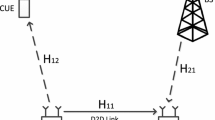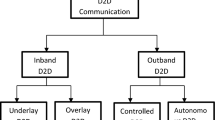Abstract
The increasing data traffic paved the way for new efficient spectrum utilisation technologies. The existing communication techniques could not cope with the proliferating demands. The major hazard for both the existing and upcoming communication system is interference. Device-to-Device (D2D) communication paradigm is being recognised as one of the promising techniques which could help with matching the data demands. The D2D users have to operate in the same spectrum of cellular users in the underlay network architecture. They must sense the spectrum availability to avoid interference. This paper analyses and reviews the number of interference mitigation techniques. The analysis made in almost all possible directions of interference mitigation considering the future generation cellular systems.








Similar content being viewed by others
Data Availability
All the data used are cited.
References
Wyglinksi, A. M., Nekovee, M., & Hou, Y. T. (2010). Cognitive radio communication and networks principles and practice. . Elseiver: Academic Press.
Min, H., Lee, J., Park, S., & Hong, D. (2011). Capacity enhancement using an interference limited area for device-to-device uplink underlaying cellular networks. IEEE Transactions on Wireless Communications, 10(12), 3995–4000.
ElSawy, H., Hossain, E., & Alouini, M.-S. (2014). Analytical modeling of mode selection and power control for underlay D2D communication in cellular networks. IEEE Transactions on Communications, 62(11), 4147–4161.
Sakr, A., & Hossain, E. (2015). Cognitive and energy harvesting-based D2D communication in cellular networks: Stochastic geometry modeling and analysis. IEEE Transactions on Communications, 63(5), 1867–1880.
Lei, L., Zhong, Z., Lin, C., & Shen, X. (2012). Operator controlled device-to-device communications in LTE-advanced networks. IEEE Wireless Communications, 19(3), 96–104.
Feng, H., Wang, H., Xu, X., & Xing., C. (2014). A tractable model for device-to- device communication underlaying multi-cell cellular networks. IEEE International Conference on Communications Workshops (ICC), pp. 587–591.
Kim, J., Karim, N. A., & Cho, S. (2017). An interference mitigation scheme of device-to-device communications for sensor networks underlying LTE-A. Sensors, 17, 1088.
Fantacci, R., Tarchi, D., & Habib, I. (2009). Adaptive modulation and coding for OFDMA systems. IEEE Transactions on Wirelesss Communications., 8(9), 4876–4883.
Andrews, J. G. (2005). Interference cancellation for cellular systems: A contemporary overview. IEEE Wireless commuications, 12, 19–29.
Kobayashi, M., Boutros, J., & Caire, G. (2001). Successive interference cancellation with SISO decoding and EM channel estimation. IEEE JSAC, 19(8), 1450–1460.
Serkan, U., Gunther, A., Zubin, B., (2011). Graph based dynamic frequency reuse in femtocell networks. 978–1–4244–8331–0/11/$26.00 IEEE.
Jia-Shi, L., Kai-Ten, F. (2011). Game theoretical model and existence of win-win situation for femtocell. 978–1–61284–233–2/11/$26.00 IEEE.
Helena, W., Sung-Yeop, P., Dong-Ho, C. (2010). Interference mitigation based on femtocells grouping in low duty operation. 978–1–4244–3574–6/10/$25.00 IEEE.
Huan, S., Linling, K., Jianhua, L. (2009). Interference avoidance in OFDMA-based femtocell network. IEEE Youth conference on information, computing and telecommunication. 978–1–4244–5076–3/09/$26.00. IEEE.
Ningombam ,D. D., Lee C. G., Shin S. (2019). Interference mitigation for multicast D2D communications underlay cellular networks. 978–1–5386–7822–0/19/$31.00 IEEE.
Subra, S.S., Hazra, R. (2020). Interference mitigation methods for D2D communciations in 5G network.Cognitive informatics and soft computing. Advances in intelligent systems and computing, vol 1040. Springer
Yin, R., Yu, G., Zhang, H., Zhang, Z., & Li, G. Y. (2015). Pricing-based interference coordination for D2D communications in cellular networks. IEEE Transactions on Wireless communications., 14(3), 1519–1532.
Yang, C., Li, J., Sheng, M., Anpalagan, A., & Xiao, J. (2017). Mean field game-theoretic framework for interference and energy-aware control in 5G ultra-dense networks. IEEE Wireless Communications, 25(1), 114–121.
Yang, C., Li, J., Semasinghe, P., Hossain, E., Perlaza, S. M., & Han, Z. (2016). Distributed interference and energy-aware power control for ultra-dense D2D networks: A mean field game. IEEE Transactions on Wireless Communication, 16(2), 1205–1217.
Mkiramweni, M. E., Yang, C., Li, J., & Han, Z. (2018). Game-theoretic approaches for wireless communications with unmanned aerial vehicles. IEEE Wireless Communications, 25(6), 104–112.
Zhou, Z., Dong, M., Ota, K., Shi, R., Liu, Z., & Sato, T. (2015). Game-theoretic approach to energy- efficient resource allocation in device-to-device underlay communications. IET Communications, 9(3), 375–385.
AlQerm, I., Shihada, B. (2016). A cooperative online learning scheme for resource allocation in 5G systems. IEEE International Conference on Communications (ICC), pp. 1–7.
Xu, J., Gu, X., Fan, Z. (2018). D2D power control based on hierarchical extreme learning machine. IEEE 29th Annual International Symposium on Personal, Indoor and Mobile Radio Communications (PIMRC), pp. 1–7.
Park, J., Choi, H. H., & Lee, J. R. (2019). Flocking-inspired transmission power control for fair resource allocation in vehicle-mounted mobile relay networks. Transactions on Vehicular Technology., 68(1), 754–764.
Funding
No funding is received for this research work.
Author information
Authors and Affiliations
Contributions
The idea is conceived and literature search is performed by Dhilipkumar. Performance evaluation and Comparison analyses were supported by Arunachalperumal.
Corresponding author
Ethics declarations
Conflict of interest
The authors declare that they have no competing interest.
Code Availability
All the data used are cited.
Additional information
Publisher's Note
Springer Nature remains neutral with regard to jurisdictional claims in published maps and institutional affiliations.
Rights and permissions
About this article
Cite this article
Dhilipkumar, S., Arunachalaperumal, C. Performance Evaluation of Interference Mitigation Scheme with D2D Users in Wireless Networks. Wireless Pers Commun 119, 3399–3412 (2021). https://doi.org/10.1007/s11277-021-08413-3
Accepted:
Published:
Issue Date:
DOI: https://doi.org/10.1007/s11277-021-08413-3




